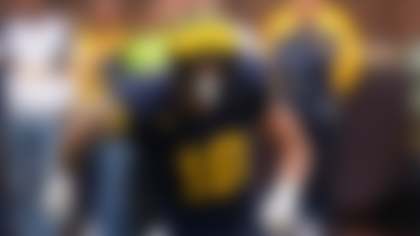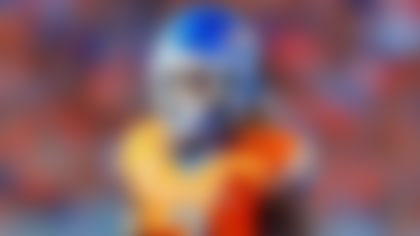Why provide instant grades on the selections of prospects who have yet to take an NFL snap? Well, you're reading this, aren't you? Considering the makeup of every roster and the factors surrounding each pick, Gennaro Filice and Nick Shook attempted a division-by-division assessment of the 2018 NFL Draft. Click here for those full breakdowns.
Below you'll find a ranking, from 1 to 32, of the 2018 draft classes. Gennaro and Nick decided the final pecking order through a combination of voting and good old-fashioned debate. No punches were thrown.
**» Round 2:** (No. 39)
James Daniels, OL, Iowa; (No. 51)
Anthony Miller, WR, Memphis.
**» Round 4:** (No. 115)
Joel Iyiegbuniwe, LB, Western Kentucky.
**» Round 5:** (No. 145)
Bilal Nichols, DL, Delaware.
**» Round 6:** (No. 181)
Kylie Fitts, Edge, Utah.
**» Round 7:** (No. 224)
Javon Wims, WR, Georgia.
This offseason in Chicago's been Mitchapalooza. The franchise has done everything possible to make its second-year quarterback feel comfortable, starting with the hiring of the hottest young offensive mind available (Matt Nagy) and continuing with a splurge on free-agent pass catchers ( Allen Robinson, Taylor Gabriel and Trey Burton). The Bears maintained this game plan in the draft -- well, after No. 8 overall, when they acquired their defensive Mitchell Trubisky, Roquan Smith. (The inside linebacker's a perfect quarterback for Vic Fangio's defense, boasting the versatile skill set and football IQ today's NFL teams crave in second-level defenders.) After that, Ryan Pace went back to pampering his 23-year-old signal-caller. Daniels, an interior O-lineman who spent much of the pre-draft process as a first-round mock mainstay, feels like a steal at No. 39. And Miller instantly become a favorite of anyone who popped in his tape, as a hyper-competitive playmaker who gets absolutely everything out of his 5-11, 201-pound frame. Yeah, life is good these days for "The Pretty Boy Assassin," who's being put in prime position for a breakout sophomore campaign. One note on the Day 3 haul: Nichols was a small-school favorite of Draft Twitter, especially after his fine showing at the East-West Shrine Game. Sleeper potential. With a nice draft-day video.
**» Round 2:** (50)
Connor Williams, OL, Texas.
**» Round 3:** (81)
Michael Gallup, WR, Colorado State.
**» Round 4:** (116)
Dorance Armstrong, Edge, Kansas; (137)
Dalton Schultz, TE, Stanford.
**» Round 5:** (171)
Mike White, QB, Western Kentucky.
**» Round 6:** (193)
Chris Covington, LB, Indiana; (208) Cedrick Wilson, WR, Boise State.
**» Round 7:** (236)
Bo Scarbrough, RB, Alabama.
Good hosts enjoy their own parties, and the Cowboys certainly did that. (Well, maybe besides all the trolling.) Dallas did a fine job collecting talent at the JerryWorld Jamboree of 2018. Vander Esch is a large, freakish athlete who flies to the football and is quite comfortable in coverage. He'll slot right into the starting lineup, alongside Sean Lee and Jaylon Smith at linebacker. Williams, who grew up in the Dallas suburbs and played his college ball at Texas, apparently is poised to compete for the starting left guard spot, keeping La'el Collins at right tackle. (Though the 'Boys can swap those two if they so desire, as Williams spent his entire stay in Austin as the Longhorns' starting left tackle.) This O-line remains one of the league's deepest and very best. Pro Football Focus darling Michael Gallup can't fill the pass-catching vacuum by himself, but don't be surprised if he contributes steady returns in Year 1. Cedrick Wilson, another PFF favorite, carries some sleeper potential of his own. The cherry on top: Bo Scarbrough in Round 7. Spelling Ezekiel Elliott is a fine role for a 228-pound hammer who needs the kind of runway to get going that Dallas' O-line will provide.
**» Round 2:** (No. 47)
Christian Kirk, WR, Texas A&M.
**» Round 3:** (No. 97)
Mason Cole, C, Michigan.
**» Round 4:** (No. 134)
Chase Edmonds, RB, Fordham.
**» Round 6:** (No. 182)
Chris Campbell, CB, Penn State.
**» Round 7:** (No. 254)
Korey Cunningham, OT, Cincinnati.
Honest admission: Steve Keim locked up an "A" on this assignment the moment he called in Arizona's first pick. Sitting at No. 15 to open the night, the Cardinals appeared to be out of range in the Big Four Quarterback Hunt. But when Rosen made it through the genuinely QB-starved organizations and remained available with Oakland on the clock at No. 10, Keim pounced. After paying a modest price to move up five slots, this transitioning franchise suddenly had a strapping young quarterback to build around. Truthfully, Arizona's draft could've gone off the rails from there, and it still would've been a highly successful weekend. But no, Keim and Co. kept on fortifying the roster under first-year head coach Steve Wilks. With the next two picks, the Cards spoiled their new signal-caller with an explosive slot target (Kirk) and a smart, versatile protector (Cole). Rosen must've gone from "pissed off" to pleased quite swiftly. Now he just has to clear his good name in airport gossip circles.
**» Round 2:** (40)
Courtland Sutton, WR, SMU.
**» Round 3:** (71)
Royce Freeman, RB, Oregon; (99)
Isaac Yiadom, CB, Boston College.
**» Round 4:** (106)
Josey Jewell, LB, Iowa; (113)
DaeSean Hamilton, WR, Penn State.
**» Round 5:** (156)
Troy Fumagalli, TE, Wisconsin.
**» Round 6:** (183)
Sam Jones, C, Arizona State; (217)
Keishawn Bierria, LB, Washington.
**» Round 7:** (226)
David Williams, RB, Arkansas.
In taking Chubb fifth overall, Denver got the edge rusher it has missed since the retirement of DeMarcus Ware. At that position, it's quite a haul (at least on paper) for the Broncos, who didn't have to move up to grab a prospect who should be an immediate-impact player. From there, John Elway added a big-bodied receiver (Sutton) in a move that might prove to be prescient, with Demaryius Thomas (30) and Emmanuel Sanders (31) both getting up there in age. Elway wasn't done addressing the offense; in Round 3, he selected Freeman as a back who should contend for the starting job right away. Yiadom might end up being the best pick of this class if he replaces departed veteran Aqib Talib effectively. From there, Elway grabbed a good value in Jewell and found an interior lineman in Jones who very well could man the position for the next decade. Bierria was also a late-round, low-risk find with potentially high upside. Overall, Elway bounced back from a couple of subpar drafts by filling multiple needs.
**» Round 2:** (No. 45)
Josh Jackson, CB, Iowa.
**» Round 3:** (No. 88)
Oren Burks, LB, Vanderbilt.
**» Round 4:** (No. 133)
J'Mon Moore, WR, Missouri.
**» Round 5:** (No. 138)
Cole Madison, OL, Washington State; (No. 172)
JK Scott, P, Alabama; (No. 174)
Marquez Valdes-Scantling, WR, South Florida.
**» Round 6:** (No. 207)
Equanimeous St. Brown, WR, Notre Dame.
**» Round 7:** (No. 232)
James Looney, DE, Cal; (No. 239)
Hunter Bradley, LS, Mississippi State; (No. 248)
Kendall Donnerson, Edge, Southeast Missouri State.
Brian Gutekunst's first rodeo went pretty darn well. And while he bounced around the draft board on opening night -- deftly picking up an extra 2019 first-rounder from New Orleans in the process -- the first-year GM eventually seemed to settle into a pretty straightforward game plan: pass defense early, developmental pass catchers late. With their first two picks, the Packers grabbed a pair of corners with fine instincts, supreme ball skills ... and divergent playing styles. Alexander's a feisty, explosive trash talker who excels in press-man coverage. Jackson's long, strong and soft-spoken, having spent most of his time at Iowa in zone defense, clueing the quarterback. In the third round, Green Bay snatched Burks, a hybrid linebacker (and former safety) with the coverage skills Green Bay has seriously lacked at the position of late. On Day 3, the Pack went after a series of skyscraping wideouts: Moore (6-3), Valdes-Scantling (6-4) and St. Brown (6-5) all provide the kind of height that served the departed Jordy Nelson quite well during his tenure in Green Bay.
**» Round 2:** (No. 58)
Isaiah Oliver, CB, Colorado.
**» Round 3:** (No. 90)
Deadrin Senat, DT, South Florida.
**» Round 4:** (No. 126)
Ito Smith, RB, Southern Miss.
**» Round 6:** (No. 194)
Russell Gage, WR, LSU; (No. 200)
Foye Oluokun, LB, Yale.
Thomas Dimitroff's pretty good at his job. Since 2008, the year the Falcons hired New England's director of college scouting to take over as their general manager, Atlanta owns a 95-65 record -- the fourth-best mark in the NFL, trailing only the Patriots, Steelers and Packers. That's a testament to Dimitroff and Co.'s draft-and-develop proficiency. Starting with his very first draft pick in Atlanta (Matt Ryan), Dimitroff's displayed a keen eye for talent. Inherently, this has always been a homegrown roster. According to Pro Football Focus, the Falcons logged the fifth-most homegrown snaps in 2017. This is all a preamble to an unsurprising opinion of this draft haul: I like it. Ridley might not be a WR1 at this level, but he doesn't need to be one in Atlanta, lining up next to Julio Jones and Mohamed Sanu. Oliver brings the traits Dan Quinn desires in a corner: length, athleticism and ball skills. The Falcons have a type at defensive tackle, too: Senat's eerily similar to Grady Jarrett, as a short, stout, interior disruptor who routinely wins the leverage game. And Smith is a highly productive back who's very comfortable in the passing game -- forward-thinking insurance should Tevin Coleman walk in free agency next offseason. Again, Thomas Dimitroff's pretty good at his job.
**» Round 3:** (83)
Orlando Brown, T, Oklahoma; (86)
Mark Andrews, TE, Oklahoma.
**» Round 4:** (118)
Anthony Averett, CB, Alabama; (122)
Kenny Young, LB, UCLA; (132)
Jaleel Scott, WR, New Mexico State.
**» Round 5:** (162)
Jordan Lasley, WR, UCLA.
**» Round 6:** (190)
DeShon Elliott, S, Texas; (212)
Greg Senat, T, Wagner; (215)
Bradley Bozeman, C, Alabama.
**» Round 7:** (238)
Zach Sieler, DE, Ferris State.
Ozzie Newsome went out with a bang in his final draft as Ravens GM. The longtime personnel man addressed three major needs, grabbing a balanced tight end in Hurst who can block and catch passes and then adding a pure pass-catcher in Andrews two rounds later to immediately form a dangerous duo at the position. In between, he added a potential face of the future when he selected Jackson at No. 32, and he found a tackle who, though he fell because of a bad combine, carries a ton of upside (and some history with the team). Newsome nailed his first four picks (I'm a big Andrews fan; he plays with a style similar to that of the Giants' Evan Engram) and then used later-round picks to address the receiver position with two players who carry plenty of potential. Lasley -- Josh Rosen's best target by a long shot at UCLA -- has pro talent, but teams didn't get a good look at him because he missed three games with a suspension. Newsome used additional late picks to add depth where his starters are beginning to age. Excellent farewell draft.
**» Round 2:** (59)
Derrius Guice, RB, LSU.
**» Round 3:** (74)
Geron Christian, OT, Louisville.
**» Round 4:** (109)
Troy Apke, S, Penn State.
**» Round 5:** (163)
Tim Settle, DT, Virginia Tech.
**» Round 6:** (197)
Shaun Dion Hamilton, LB, Alabama.
**» Round 7:** (241)
Greg Stroman, CB, Virginia Tech; (256)
Trey Quinn, WR, SMU.
Despite spending last year's first-round pick on defensive lineman Jonathan Allen -- who, by the way, showed plenty of promise early in 2017 before missing the final 11 games with a Lisfranc injury -- the Redskins still needed more oomph up front. And they went right back to that fruitful football well in Tuscaloosa, snatching up Allen's former teammate. Payne's a force of nature against the rush -- no small thing for the 'Skins, who ranked dead last in run defense last season -- and anyone who watched the College Football Playoff saw his enticing inside-rush potential. Guice might have some growing up to do, but from a pure on-field standpoint, he's a highly productive, violent, bell-cow back who should've been long gone by the 59th pick. Speaking of potential steals, Settle brings a whole lot of disruption and versatility in a 6-3, 329-pound package.
**» Round 2:** (34)
Will Hernandez, OG, UTEP.
**» Round 3:** (66)
Lorenzo Carter, Edge, Georgia; (69)
B.J. Hill, DT, N.C. State.
**» Round 4:** (108)
Kyle Lauletta, QB, Richmond.
**» Round 5:** (139)
RJ McIntosh, DT, Miami.
So conflicted with the Giants' decision at No. 2 ... The devil on my shoulder says, Flame them! Everyone knows Eli's cooked. How in MY hell can you pass up a golden opportunity to snag his replacement? Angel on the other shoulder counters with, Praise them! They didn't get caught up in the quarterback hysteria and TRULY took the best player available -- the best player in this entire draft! I'm a tad partial to the angelic side here, but that devil's gonna be barking at the first sight of #EliFace. One pick I had absolutely no qualms about: Hernandez in Round 2. The nasty, neck-roll-wearing, defense-obliterating guard out of UTEP is a first-round value. What does Lauletta's selection say about Davis Webb? New GM, new halfhearted swing at the QB succession plan.
**» Round 2:** (No. 36)
Darius Leonard, LB, South Carolina State; (No. 37)
Braden Smith, G, Auburn; (No. 52)
Kemoko Turay, EDGE, Rutgers; (No. 64)
Tyquan Lewis, DE, Ohio State.
**» Round 4:** (No. 104)
Nyheim Hines, RB, N.C. State.
**» Round 5:** (No. 159)
Daurice Fountain, WR, Northern Iowa; (No. 169)
Jordan Wilkins, RB, Mississippi.
**» Round 6:** (No. 185)
Deon Cain, WR, Clemson.
**» Round 7:** (No. 221)
Matthew Adams, LB, Houston; (No. 235)
Zaire Franklin, LB, Syracuse.
After years of trotting Andrew Luck out behind a patchwork line, GM Chris Ballard finally had enough and selected not one, but two guards in the first two rounds. He gets an A for taking Nelson, and an A for doubling down on the position in Round 2 where he selected first-team All-American Smith. Suddenly, when combined with center Ryan Kelly, Indianapolis' line doesn't look all that bad. Adding Lewis and Turay is an attempt to improve on the league's 31st-highest sack total (25) in 2017, though I thought Lewis was selected one round too early. I found it surprising in a draft that was deep at running back, Ballard opted to wait until the fourth round to address the position. Marlon Mack, a fourth-rounder last year and the only returning Colts rusher to have more than 25 carries in 2018, will be joined by newcomers Hines and Wilkins, suggesting that Ballard wants to address the position with quantity over perceived quality. That's no knock on Hines, who I've enjoyed watching; it just seems to be a peculiar strategy and my reason for bringing them down from an A-.
**» Round 2:** (48)
Uchenna Nwosu, Edge, USC.
**» Round 3:** (84)
Justin Jones, DT, N.C. State.
**» Round 4:** (119)
Kyzir White, S, West Virginia.
**» Round 5:** (155)
Scott Quessenberry, C, UCLA.
**» Round 6:** (191)
Dylan Cantrell, WR, Texas Tech.
**» Round 7:** (251)
Justin Jackson, RB, Northwestern.
Los Angeles found itself with one of the best picks of the first round when James fell to No. 17. Nwosu made his living (a productive one) on the edge at USC, but he could end up playing off the ball and proving the Chargers wise for selecting him. Brandon Mebane (33) isn't getting any younger; Jones will have a chance to learn behind an established veteran while maintaining the potential to slide into the starting role in the near future. Quessenberry is an intelligent center who will have time to develop into an effective pro while sitting behind Mike Pouncey. It was interesting that the Chargers didn't select a tackle, instead adding clout to their belief in Russell Okung for at least 2018.
**» Round 2:** (42)
Mike Gesicki, TE, Penn State.
**» Round 3:** (73)
Jerome Baker, LB, Ohio State.
**» Round 4:** (123)
Durham Smythe, TE, Notre Dame; (131)
Kalen Ballage, RB, Arizona State.
**» Round 6:** (209)
Cornell Armstrong, DB, Southern Miss.
**» Round 7:** (227)
Quentin Poling, LB, Ohio; (229)
Jason Sanders, K, New Mexico.
Fitzpatrick was a man without a position, but found perhaps his best landing spot in a secondary that was already a strength of the Dolphins. He'll be able to contribute with minimal expectations, perhaps primarily as a nickelback -- the role in which he flourished at Alabama. Miami filled a pass-catching need at tight end with Gesicki, who is essentially this draft's Evan Engram (that worked out pretty well for the G-Men) and won't be needed to flatten defenders in the run game. Raekwon McMillan must have made quite the impression before his injury because, for the second straight year, Miami selected an Ohio State linebacker. Ballage projects to form a nice 1-2 punch in the backfield with Kenyan Drake once Frank Gore's homecoming tour is finished.
**» Round 2:** (No. 38)
Ronald Jones II, RB, USC; (No. 53)
M.J. Stewart, CB, North Carolina; (No. 63)
Carlton Davis, CB, Auburn.
**» Round 3:** (No. 94)
Alex Cappa, OG, Humboldt State.
**» Round 4:** (No. 117)
Jordan Whitehead, S, Pittsburgh.
**» Round 5:** (No. 144)
Justin Watson, WR, Pennsylvania.
**» Round 6:** (No. 202)
Jack Cichy, LB, Wisconsin.
Like every other sentient being, I assumed Tampa Bay would take Derwin James at No. 7 overall. The Swiss Army Knife safety out of Florida State would give the Buccaneers' secondary some needed juice, I figured. And he wouldn't even have to set foot on a plane to relocate from Tallahassee to Tampa. He'd actually be moving much closer to his hometown of Haines City, Florida! So, yes, I was a bit surprised when the Bucs traded down. And I was utterly stunned when Jason Licht opted for Vea over James at No. 12. But as the draft played out, I came to appreciate Licht's master plan ... despite the fact that I do believe Tampa could regret passing on James. The 2017 Buccaneers' defense was horrendous any way you cut it. Tampa Bay finished dead last in new-school stats ( DVOA) and old-school stats ( total defense). Come together, millennials and traditionalists -- you both know this unit was terrible. Licht clearly saw the D-line as the chief culprit, acquiring Jason Pierre-Paul, Vinny Curry, Beau Allen and Mitch Unrein in March, before adding the first-round cherry on top: an agile, 347-pound behemoth by the name of Tevita Tuli'aki'ono Tuipulotu Mosese Va'hae Fehoko Faletau Vea. With the pair of second-round picks obtained in the trade down to 12, Tampa infused its secondary with some of that needed juice referenced above, adding Stewart and Davis to the CB mix. Given all the intriguing new faces across the defense, it's easy to imagine significant improvement in 2018. That's the hope with the run game, too. Tampa spent its other two premium picks on a big-play running back (Jones) and a mauling guard (Cappa). All in all, Licht hit a number of need areas. Touche. Still think Derwin would've looked mighty nice in pewter, though.
**» Round 2:** (No. 41)
Harold Landry, EDGE, Boston College.
**» Round 5:** (No. 152)
Dane Cruikshank, S, Arizona.
**» Round 6:** (No. 199)
Luke Falk, QB, Washington State.
Tennessee didn't have a ton of picks, but for a team that has a lot of its core intact, the Titans still managed to draft efficiently. Titans GM Jon Robinson dealt some picks to maneuver and select players at positions of need, adding Rashaan Evans, who should immediately replace the departed Avery Williamson. Landry is a different type of edge defender than Brian Orakpo or Derrick Morgan, but will eventually replace one of the two, who are both over 30 years old and are in contract years. Cruikshank and Falk are good depth picks, with the former potentially serving as a backup defensive back and key special teamer and the latter growing into a reliable second-stringer behind Marcus Mariota.
**» Round 2:** (56)
Duke Dawson, CB, Florida.
**» Round 5:** (143)
Ja'Whaun Bentley, LB, Purdue.
**» Round 6:** (178)
Christian Sam, LB, Arizona State; (210)
Braxton Berrios, WR, Miami.
**» Round 7:** (219)
Danny Etling, QB, LSU; (243)
Keion Crossen, DB, Western Carolina; (250)
Ryan Izzo, TE, Florida State.
While many expected New England to go quarterback at No. 23 -- especially with Lamar Jackson still on the board -- the Patriots instead addressed an immediate need, selecting Wynn in an unusually murky year for tackles. Wynn projects for most as a guard, but his versatility adds value for a Patriots team looking to replace tackle Nate Solder. From there, New England continued to plug holes, adding Michel to replace Dion Lewis and Dawson to replace Malcolm Butler. Top to bottom, this might not be the prettiest draft in the division, but stands a good chance to end up being the most valuable. And yes, the Patriots took a quarterback, but let's not put successor weight on Etling's shoulders.
**» Round 2:** (No. 43)
Kerryon Johnson, RB, Auburn.
**» Round 3:** (No. 82)
Tracy Walker, S, Louisiana-Lafayette.
**» Round 4:** (No. 114)
Da'Shawn Hand, DE, Alabama.
**» Round 5:** (No. 153)
Tyrell Crosby, OL, Oregon.
**» Round 7:** (No. 237)
Nick Bawden, FB, San Diego State.
Hey, did anybody know the Lions haven't had a 100-yard rusher since Thanksgiving day 2013?? [Ducks four-ton haymaker from Detroit's Joe Louis fist] Yeah, every single Lions supporter is sick and tired of this go-to statistical burn. Not because it's irrelevant -- Detroit's ground game has ranked 32nd, 30th and 32nd over the past three seasons -- but because it's the exact kind of humiliating, interminable ineptitude that routinely causes proud Detroiters to shake their heads and utter those three tortured words: Same old Lions. Well, Bob Quinn and Matt Patricia say enough is enough! Detroit devoted four of its six picks to solving this problem once and for all, starting with Ragnow, Pro Football Focus' top-rated college center in each of the past two years. He immediately slots into the starting lineup at either center or guard, depending on where the Lions want to put Graham Glasgow. (The guess here is that Ragnow mans the pivot.) In Round 2, the Lions added Johnson, a powerful, jump-cutting back with a Le'Veon Bell-like patience that rewards good blocking. On Day 3, Detroit scooped up two more punishing run blockers, including a fullback. (Yes, a fullback! That 100-yard drought is squarely in the crosshairs.) So, what about replenishments for the 27th-ranked defense? Well, you can only fill so many needs in one draft. But yes, the limited haul there is what keeps Detroit out of "A" territory. Will Walker or Hand make a significant impact? Both offer intriguing size and tools. Oh, and one huge bonus for those Lions fans who back the Wolverines on Saturdays: Finally got your guy!
**» Round 2:** (No. 44)
Dante Pettis, WR, Washington.
**» Round 3:** (No. 70)
Fred Warner, LB, BYU; (No. 95)
Tarvarius Moore, S, Southern Miss.
**» Round 4:** (No. 128)
Kentavius Street, DE, N.C. State.
**» Round 5:** (No. 142)
D.J. Reed, CB, Kansas State.
**» Round 6:** (No. 184)
Marcell Harris, S, Florida.
**» Round 7:** (No. 223)
Jullian Taylor, DT, Temple; (No. 240)
Richie James, WR, Middle Tennessee State.
Thanks to Jimmy G's dandy December, the 49ers have spent this offseason as the most buzzed-about 6-10 team in recent memory. But when a quarterback's nickname gets a messianic makeover -- Jimmy Geesus -- well, you gotta make sure that guy's well-protected for the foreseeable future. At this time last week, the 49ers appeared to be pretty well-equipped on the bookends -- at least at first blush -- with Joe Staley on the left side and Trent Brown on the right. But with Staley closing in on his 34th birthday and Brown's free agency on the horizon next offseason (not to mention, Brown's current health status), John Lynch saw the writing on the wall -- it said, "Go get a young tackle. Like, NOW!" Only problem: paper-thin tackle draft class. So, did the Niners overdraft McGlinchey? Maybe a little bit. But the move allowed them to flip Brown to New England for a third-rounder (which ended up netting a long, lightning-fast safety in Moore), so that's value added. Now the 6-8 Notre Dame product will start at right tackle while apprenticing under Staley to eventually take over the blind side. Like this kind of forward-thinking roster management. Also like both of San Francisco's Day 2 picks: Pettis and Warner, a playmaker for each side of the ball. And Street seems like a worthwhile gamble late in the fourth round, though I won't blame the 49er Faithful if they're sick of rookie redshirts after the Baalke era.
**» Round 4:** (125)
Avonte Maddox, CB, Pittsburgh; (130)
Josh Sweat, Edge, Florida State.
**» Round 6:** (206)
Matt Pryor, OT, TCU.
**» Round 7:** (233)
Jordan Mailata, OT, N/A.
The Eagles only made five picks in this draft, but the first three of them make the grade here. Philadelphia actually moved out of the No. 32 slot -- allowing Baltimore to take Lamar Jackson -- but earned a 2019 second-round pick for their generosity. The Eagles then proceeded to jump right in front of the TE-needy Cowboys and nab Goedert. Doug Pederson's a fan of 12 personnel (one RB, two TE), and I'm a fan of Goedert joining Zach Ertz. In the fourth round, Philly scooped up a slot corner replacement for Patrick Robinson (Maddox) and a high-upside edge rusher (Sweat) to further enrich that terrifying front. The Eagles are loaded for bear, fully prepared for a title defense. Remember three years ago, in the Chip Kelly era, when Howie Roseman was essentially forced to take a GM sabbatical? Weird league.
**» Round 3:** (72)
Nathan Shepherd, DT, Fort Hays State.
**» Round 4:** (107)
Chris Herndon, TE, Miami.
**» Round 6:** (179)
Parry Nickerson, CB, Tulane; (180)
Foley Fatukasi, DT, Connecticut; (204)
Trenton Cannon, RB, Virginia State.
The strength of this class relies heavily on the potential of Darnold at No. 3 overall, but is supplemented by Shepherd's value as an immediate starter on New York's defense. From there, we have more unknowns, with Herndon arriving as a raw prospect with plenty of athletic ability, enough to validate a fourth-round selection and anticipated learning year behind Jordan Leggett and Clive Walford. Eventually, he could be seen as quite a value grab, should he turn that athleticism into productivity.
**» Round 2:** (No. 55)
Donte Jackson, CB, LSU.
**» Round 3:** (No. 85)
Rashaan Gaulden, S, Tennessee.
**» Round 4:** (No. 101)
Ian Thomas, TE, Indiana; (No. 136)
Marquis Haynes, Edge, Mississippi.
**» Round 5:** (No. 161)
Jermaine Carter, LB, Maryland.
**» Round 7:** (No. 234)
Andre Smith, LB, North Carolina; (No. 242)
Kendrick Norton, DT, Miami.
There was no Julio Jones or A.J. Green in this draft. (Man, that 2011 draft ... The first round's draft porn -- unless you took a quarterback not named Cam Newton.) But there was a catch-and-run wizard with a running back's bulk, a slot's agility and an outside receiver's long speed. Moore's a six-foot package of playmaking -- really a thrill to watch in the open field. Eclipsing the 1,000-yard mark in his final season at Maryland was no small feat, given how cursed/crummy Terp quarterbacks were during Moore's time in College Park. Another juicy pick: The very first player off the board on Day 3. With just one year of high-level starting experience under his belt, Thomas needs more gridiron reps. But the 6-4, 259-pounder's raw athletic traits are easy to see -- and en vogue at the tight end position. Those two picks were sandwiched around a pair of secondary reinforcements: Jackson can run really, really, ridiculously fast -- as he displayed in 4.32 seconds at the combine -- while Gaulden's more of a technician who could excel as a big nickel corner. The biggest problem I see with this draft class is that I don't see any offensive linemen.
**» Round 2:** (33)
Austin Corbett, G, Nevada; (35)
Nick Chubb, RB, Georgia.
**» Round 3:** (67)
Chad Thomas, DE, Miami.
**» Round 4:** (105)
Antonio Callaway, WR, Florida.
**» Round 5:** (150)
Genard Avery, LB, Memphis.
**» Round 6:** (175)
Damion Ratley, WR, Texas A&M; (188)
Simeon Thomas, DB, Louisiana-Lafayette.
The last time Cleveland took a quarterback in the first round, it also selected a cornerback, and both of those selections were widely praised. Those two players ended up being Johnny Manziel and Justin Gilbert. We're not holding this against Mayfield or Ward, because, while some are split on the polarizing Mayfield, I can personally tell you Ward is a good kid ( read more about why here). He's also an excellent cover corner and the clear best corner in the draft; while he went higher than expected, it was not without merit. Kudos to the Browns for taking their guy, even with pass rusher Bradley Chubb still on the board. Beyond there, Cleveland found someone who I think will fit well at either guard or tackle (likely tackle) in Corbett, whose film is a treat to watch. Chubb will slide into a role similar to the one he manned at Georgia, albeit with a little bit more variety in terms of fellow backs, alongside Carlos Hyde and Duke Johnson. Thomas stands to serve as a more athletic rotational edge rusher in a front four that's suddenly rather menacing. Where I dock Cleveland is for trading up to draft Callaway, who couldn't keep himself on the field due to troubles off it. But GM John Dorsey does not -- as he's shown with this draft -- give a damn what anyone outside the organization thinks.
**» Round 2:** (54)
Jessie Bates, S, Wake Forest.
**» Round 3:** (77)
Sam Hubbard, DE, Ohio State; (78)
Malik Jefferson, LB, Texas.
**» Round 4:** (112)
Mark Walton, RB, Miami.
**» Round 5:** (151)
Davontae Harris, CB, Illinois State; (158)
Andrew Brown, DT, Virginia; (170)
Darius Phillips, CB, Western Michigan.
**» Round 7:** (249)
Logan Woodside, CB, Toledo; (252)
Rod Taylor, G, Mississippi; (253)
Auden Tate, WR, Florida State.
A lot of this grade is based on the potential of the Bengals' first four picks, who all have a ton of upside. Price was about as reliable as possible at Ohio State in the interior, tying Pat Elflein (now with the Minnesota Vikings) for Ohio State's record with 55 straight starts. Though he tore his pectoral muscle while benching at the combine, his repair and recovery have gone well, and he's expected to contribute when the season arrives, shoring up what was a major weakness for the Bengals. Combined with the trade for Cordy Glenn, Cincinnati made great strides in addressing its line. Beyond Price, Bates will eventually take over at safety and has more upside as a pro than his brief college career showed. The most value lies in the selections of Hubbard and Jefferson, who each carry the potential to become major contributors in their second and third seasons and end up being great value picks. Woodside should serve as the ideal backup to Andy Dalton after the departure of AJ McCarron.
**» Round 3:** (96)
Harrison Phillips, DT, Stanford.
**» Round 4:** (121)
Taron Johnson, CB, Weber State.
**» Round 5:** (154)
Siran Neal, S, Jacksonville State; (166)
Wyatt Teller, OG, Virginia Tech.
**» Round 6:** (187)
Ray-Ray McCloud, WR, Clemson.
**» Round 7:** (255)
Austin Proehl, WR, North Carolina.
The top pick here generates the most buzz, but I'm in the group that thinks he doesn't end up panning out, due to multiple red flags too often covered up by a rare arm. My opinion on Allen's fate aside, the potential is still there, and Buffalo didn't have to move into the top four to take him. It was just one of many maneuvers made by GM Brandon Beane, who's attempting to quickly reshape Buffalo's roster in his image. His efforts saw their best two additions come in the next two picks: Edmunds and Phillips, who both bring Day 1-starter potential. Phillips, a 1-technique who could also slide out to the 3 in Buffalo, is the ideal replacement for Kyle Williams, who's close to retirement. McCloud is a guy who didn't get a ton of looks at Clemson, but had a solid NFL Scouting Combine workout and could end up being a late-round value guy.
**» Round 2:** (No. 61)
D.J. Chark, WR, LSU.
**» Round 3:** (No. 93)
Ronnie Harrison, S, Alabama.
**» Round 4:** (No. 129)
Will Richardson, T, N.C. State.
**» Round 6:** (No. 203)
Tanner Lee, QB, Nebraska.
**» Round 7:** (No. 230)
Leon Jacobs, EDGE, Wisconsin; (No. 247)
Logan Cooke, P, Mississippi State.
Dave Caldwell can't get enough of front-seven defenders, apparently, but that's not a bad thing with this squad. Bryan will arrive in Jacksonville as a reliable rotational player, which was a major key to the Jaguars' sustained rush in 2017, thanks to rotating in players such as Marcell Dareus. I wrote about Jacksonville's suddenly concerning receiving corps after the departure of Allen Robinson, but I'm glad to say they've found his replacement in Chark, a big receiver who commands respect in the deep game with a 4.34 40-yard dash time. Harrison stands to become the hammer on the back end of Jacksonville's secondary, bringing a wallop between corners Jalen Ramsey and A.J. Bouye. Richardson is a depth pick who could end up unseating Jermey Parnell at right tackle down the road. It wasn't an eye-popping draft, but looks like it should produce three contributors, which is solid.
**» Round 2:** (No. 62)
Brian O'Neill, OT, Pittsburgh.
**» Round 4:** (No. 102)
Jalyn Holmes, DE, Ohio State.
**» Round 5:** (No. 157)
Tyler Conklin, TE, Central Michigan; (No. 167)
Daniel Carlson, K, Auburn.
**» Round 6:** (No. 213)
Colby Gossett, OG, Appalachian State; (No. 218)
Ade Aruna, Edge, Tulane.
**» Round 7:** (No. 225)
Devante Downs, LB, Cal.
Colleague Cynthia Frelund, who concocted a model that projects future player performance, identified Hughes as one of the best value picks in Round 1. I don't possess Cynthia's mental capacity, but I do share her appraisal of this selection. Tom Pelissero detailed the off-field issues that led to Hughes leaving the North Carolina football program. If Hughes maintains proper conduct off the field, he's quite an asset on it -- as a physical, ballhawking corner and an explosive return man. With All-Pro Xavier Rhodes locked into one CB slot, Hughes' selection applies pressure on 2016 second-round pick Mackensie Alexander and 2015 first-rounder Trae Waynes. Offensive line is another area that called for attention heading into this draft -- did the Vikes do enough there? O'Neill's a fine athlete at 6-7, 297 pounds, but he has a ways to go on the fundamentals front. Gossett has NFL size, but his game needs to marinate. Moving over to tight end, Conklin caries health concerns, having suffered a Jones fracture in his foot last August. If he can stay healthy, the former Chippewa has potential as a move TE/H-back in new offensive coordinator John DeFilippo's offense (the Trey Burton role).
**» Round 4:** (No. 103)
Keke Coutee, WR, Texas Tech.
**» Round 6:** (No. 177)
Duke Ejiofor, DE, Wake Forest; (No. 211)
Jordan Thomas, TE, Mississippi State; (No. 214)
Peter Kalambayi, EDGE, Stanford.
**» Round 7:** (No. 222)
Jermaine Kelly, DB, San Jose State.
A lot of Houston's draft was spent last year when it traded up to get Deshaun Watson, which seems like a wise move at this point. As a result (plus the cleansing of Brock Osweiler that cost them a second-round pick), the Texans didn't have a selection until the third round, but were still able to found a smart, instinctive safety with the size and speed teams desire -- and they got him a round later than he was projected. Houston found a swing lineman in Rankin, who's listed at center but earned All-SEC honors playing tackle. His versatility (borne out of some weaknesses at certain positions) should prove valuable for a team that's needed to improve the group. Akins was a former minor league baseball player and is a 26-year-old rookie who has pass-catching ability, but was selected much earlier than expected. Coutee could end up being a good value pick thanks to his 4.43 speed.
**» Round 4:** (No. 111)
Brian Allen, C, Michigan State; (No. 135)
John Franklin-Myers, DE, Stephen F. Austin.
**» Round 5:** (No. 147)
Micah Kiser, LB, Virginia; (No. 160)
Ogbonnia Okoronkwo, Edge, Oklahoma.
**» Round 6:** (No. 176)
John Kelly, RB, Tennessee; (No. 192)
Jamil Demby, OG, Maine; (No. 195)
Sebastian Joseph, DT, Rutgers; (No. 205)
Trevon Young, Edge, Louisville.
**» Round 7:** (No. 231)
Travin Howard, LB, TCU; (No. 244)
Justin Lawler, DE, SMU.
Yes, the Rams entered last weekend without many premium picks, having spent draft currency to acquire Brandin Cooks, Marcus Peters and Aqib Talib earlier this offseason. Seems like good business to me, knowing that the Rams are undoubtedly entering the 2018 campaign with understandable win-now intentions. So, how did Les Snead handle the remaining draft resources in last week's three-day affair? That's what I felt this grade should reflect. My judgment: Not too shabby. With their only pick in the first two days of the draft, the Rams selected a developmental tackle with promising tools and athleticism (Noteboom) -- wise move, given that Andrew Whitworth's not getting any younger. Another idea I liked: Racking up a bunch of Day 3 lottery tickets and playing the numbers game. Snead peppered need areas (linebacker, O-line/D-line depth) with a bunch of prospects. Not hard to imagine a few sticking. Three stood out to me: Allen (a smart, nasty center), Okoronkwo (a high-motor edge whose production far outshines his underwhelming traits) and Kelly (a hard-charging, versatile back who can spell Todd Gurley).
**» Round 2:** (60)
James Washington, WR, Oklahoma State.
**» Round 3:** (76)
Mason Rudolph, QB, Oklahoma State; (92)
Chuks Okorafor, T, Western Michigan.
**» Round 5:** (148)
Marcus Allen, S, Penn State; (165)
Jaylen Samuels, RB, N.C. State.
**» Round 7:** (246) Joshua Frazier, DT, Alabama.
Pittsburgh's choice of Edmunds made history and also raised eyebrows, as it came much earlier than anticipated. Edmunds comes from a strong NFL lineage, though, and could prove the Steelers right in the long run. Washington is an immediate deep-threat replacement for Martavis Bryant (who was traded to the Raiders), and Rudolph is the successor to Ben Roethlisberger that Pittsburgh needed, even if it creates some drama in the short term. Okorafor doesn't have the most reliable tape, but he could develop into a solid tackle with the right tutoring under offensive line coach Mike Munchak. Allen adds safety depth for a team that spent its first pick on the position but also saw major turnover in the offseason. Though they're getting a B- now, this grade stands to improve tremendously if Rudolph ends up taking over at QB after the Roethlisberger era ends and Edmunds turns out to be a reliable starter.
**» Round 3:** (75)
Derrick Nnadi, DT, Florida State; (100)
Dorian O'Daniel, LB, Clemson.
**» Round 4:** (124)
Armani Watts, S, Texas A&M
**» Round 6:** (196)
Tremon Smith, CB, Central Arkansas; (198)
Kahlil McKenzie, DT, Tennessee.
Speaks is a quality football player, but many deemed his selection too high. Then again, if he's your guy, go get him, right? Speaks should provide an edge presence in the absence of departed veteran Tamba Hali. Kansas City then fortified its front four by going with a defensive tackle in Nnadi to compete with restricted free-agent signing Xavier Williams. The Chiefs grabbed an experienced college player in four-year starter Watts for the secondary, but they waited until the sixth round to select a cornerback, after the franchise traded away Marcus Peters. An all-defense draft isn't bad for a team that needed replenishing on that side of the ball, but the players chosen will leave much of this analysis up for a re-grade a year or two from now.
**» Round 2:** (57)
P.J. Hall, DT, Sam Houston State.
**» Round 3:** (65)
Brandon Parker, OT, North Carolina A&T; (87)
Arden Key, Edge, LSU.
**» Round 4:** (110)
Nick Nelson, CB, Wisconsin.
**» Round 5:** (140)
Maurice Hurst, DT, Michigan; (173)
Johnny Townsend, P, Florida.
**» Round 6:** (216)
Azeem Victor, LB, Washington.
**» Round 7:** (228)
Marcell Ateman, WR, Oklahoma State.
Jon Gruden's return to coaching brought the influence of late owner Al Davis, who at times appeared to be drafting for the Raiders from the great beyond. Oakland took perceived risks in selecting Key, a high-upside edge rusher, then doubled down on red flags by grabbing Victor, who struggled to stay on the field in his final two seasons due to multiple suspensions. If both players pan out, it'll end up looking like a genius pair of selections, but the "if" is big. Credit is due for getting ahead of a looming issue at tackle with the choice of Miller, who will eventually replace veteran Donald Penn. The news of Vadal Alexander's suspension also brings more sense to the selection of Parker. Hurst is a boom-or-bust prospect due to health issues, but he could bring great value if he is available more often than not. This is a group that could look much, much better in a few years, but it carries a lot of risk right now.
**» Round 3:** (No. 79)
Rasheem Green, DE, USC.
**» Round 4:** (No. 120)
Will Dissly, TE, Washington.
**» Round 5:** (No. 141)
Shaquem Griffin, LB, UCF; (No. 146)
Tre Flowers, S, Oklahoma State; (No. 149)
Michael Dickson, P, Texas; (No. 168)
Jamarco Jones, OT, Ohio State.
**» Round 6:** (No. 186)
Jake Martin, Edge, Temple.
**» Round 7:** (No. 220)
Alex McGough, QB, Florida International.
A good ground game would indeed help Russell Wilson. And regardless of where he ranked on your pre-draft big board, Penny is the kind of well-rounded, stout back who can make an immediate impact in the NFL. But a good ground game also requires a decent offensive line. And that's something Seattle has lacked for years. Prior to the draft, Matt Harmon astutely explained why "run blocking" is the Seahawks' fatal flaw. What did they do to calm Harmon's nerves? Wait until late in the fifth round to select an offensive tackle who bombed the combine, spawning questions about his athleticism and work ethic. On the defensive side of the ball -- you know, the side that's seen a massive talent drain this offseason -- Seattle spent a third-round pick on Green, whose inside-outside skill set pegs him as a potential Michael Bennett replacement. But dude's raw. Here's what an AFC regional scout told Lance Zierlein: "I wanted him to go back to school because he probably would have been a top-10 pick next year. He's not strong enough to handle NFL guys yet so this year may be a redshirt year for him." So let's stick a pin in those Bennett comps for now. Griffin's an inspiring story who tore up college football as a heat-seeking missile off the edge. It will be very interesting to see how Seattle deploys the 227-pounder at this level.
**» Round 3:** (No. 91)
Tre'Quan Smith, WR, UCF.
**» Round 4:** (No. 127)
Rick Leonard, OT, Florida State.
**» Round 5:** (No. 164)
Natrell Jamerson, S, Wisconsin.
**» Round 6:** (No. 189) Kamrin Moore, CB, Boston College; (No. 201)
Boston Scott, RB, Louisiana Tech.
**» Round 7:** (No. 245)
Will Clapp, C, LSU.
The Saints were essentially in the NFC title game ... Then Marcus Williams' brain froze, allowing Minnesota to perform a miracle. So, it's not hard to understand why Mickey Loomis, Sean Payton and Co. would be tempted to go hard after an edge rusher to push them over the top. But this report card says they went too hard. Far too hard. Caution, meet wind. In today's NFL, giving up a future first-rounder is rare. This isn't the NBA. These babies are the Berkshire Hathaway stock of the NFL draft market. Typically, teams only give 'em up for quarterbacks. And shoot, four teams actually did trade up to snag a first-round QB in this draft -- nary a one forfeited a future first-rounder. So it was indeed shocking to see New Orleans sacrifice a 1 for an unfinished non-quarterback. Could Davenport immediately take the league by storm, pile up sacks in bunches and fire this grade into the sun? Stranger things have happened. But to me, the probability of such a reward just wasn't worth this risk. Payton comparing New Orleans' reckless abandon to the national debt isn't helping. I could provide some quick analysis on the remaining picks -- Tre'Quan's turbo-charged lankiness is cool! -- but let's be honest: This grade's all about the first-round head-scratcher.











